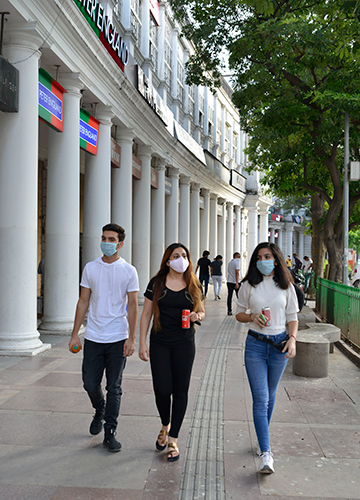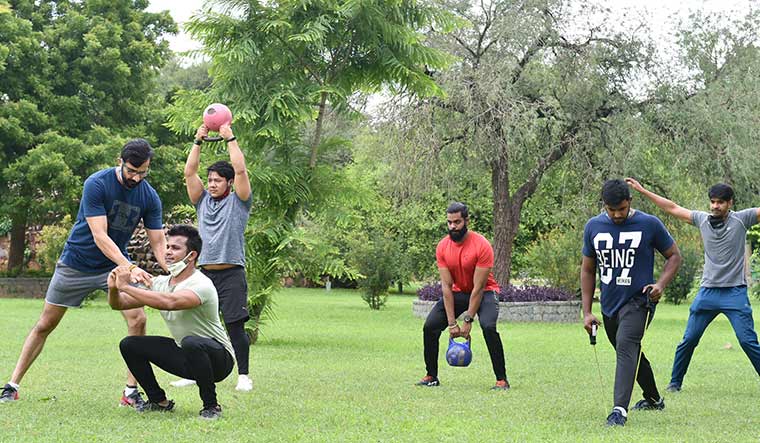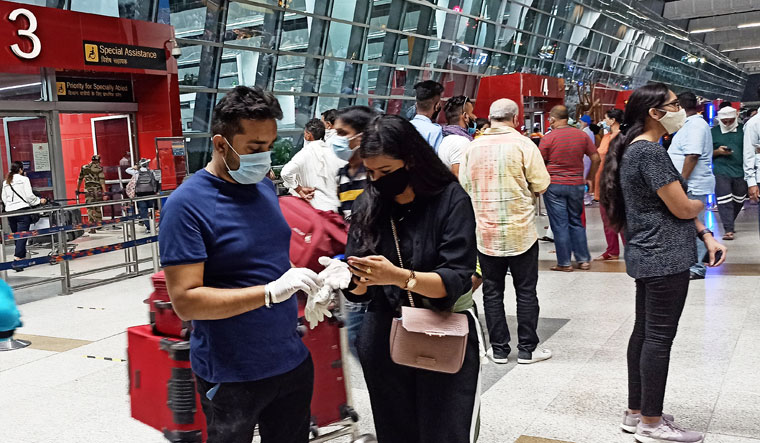Delhi is well past its Covid-19 peak.
The peak had come in June, when a deluge of cases had exposed an acute shortage of hospital beds and testing kits. The prognosis looked grim: Cases were expected to surge to five lakh by the end of July.
By August, though, the state government had turned things around. The test positivity rate, which stood at 31.66 per cent on June 14, fell to around 6 per cent two months later. A high positivity rate indicates that only the potentially sick are being tested; a low positivity rate points to the slowdown of the spread.
The slowdown in Delhi has been significant. On September 1, it reported 2,312 new cases, up from the seven-day average of 1,855, but well below the peak in June (3,947 cases). With 14,626 patients, Delhi is now fourteenth among states in terms of the number of active cases. There have been 1.77 lakh cases and nearly 4,500 deaths.
“Things changed when the focus shifted from providing only tertiary care to giving primary-level care for those with mild disease,” says Dr K. Srinath Reddy, president, Public Health Foundation of India. “The strategy of segregating people with mild symptoms for home isolation, providing them pulse oximeters and thermometers, and following up with them worked.”
The involvement of AYUSH medical practitioners helped preempt shortage of manpower. “Kerala, for instance, involved only allopathic doctors initially, giving rise to a shortage. In Delhi, AYUSH doctors have been involved, since April 14, in testing centres, Covid care centres and even hospitals,” says Dr Amar Bodhi R., associate professor at the Delhi government’s Dr B.R. Sur Homoeopathic Medical College and Research Centre.
Bodhi, who was in charge of six testing centres in Delhi, said the practice of segregating patients worked. “If patients did not show symptoms or had just mild ones, and if they had a separate toilet at home, we would send them into home isolation,” he said. “If they had elderly relatives at home, we would put them in institutional isolation. If they had co-morbidities, or symptoms such as fever over 102 degrees Fahrenheit, blood pressure less than 90/60, pulse rate more than 120 and [oxygen level] less than 95, then they would be sent to a hospital.”
The number of cases came down also because of the natural course of the Covid-19 spread. “In many urban conglomerations, the infection peaks after a certain number of people are infected; then it begins to stabilise,” said Dr Sumit Ray, head, critical care, Holy Family Hospital. “In New York, the infections peaked at about 20 per cent seropositivity (the instance of blood serum testing positive for a virus). In Delhi, it happened after 23 per cent seropositivity. We were right at the point of being overwhelmed when cases began to stabilise. A younger population also meant fewer deaths. Medical management in the country, as in the city, was better because we had the advantage of learning from the experience of European countries.”
Since August 21, though, there has been a rise in the number of cases and containment zones. Positivity rate has risen to around 11 per cent, owing to the phasing out of the lockdown and the influx of patients from outside the state. To tackle the situation, the government will increase testing from 20,000 tests a day to 40,000.
But a significant number of these tests will be rapid antigen tests, which experts say are less than accurate. The gold standard is the reverse transcription polymerase chain reaction (RT-PCR) test. But Delhi, which has two crore people, conducts only 5,000 to 6,000 RT-PCR tests a day. The number is grossly inadequate, said a health ministry official. Chennai, for instance, conducts 8,000 to 10,000 tests; it has a population of 80 lakh.
Chief Minister Arvind Kejriwal knows that the fight is far from over. In an exclusive interview, he spoke about his plan to refine the Covid strategy to save lives and livelihoods. “Aggressive testing is a pillar of the Delhi model,” he told THE WEEK. “That is the only way we can identify and isolate patients early on.”
Excerpts from the interview:
Q/ Covid-19 cases in Delhi had stabilised, but a slight increase is now causing concern. How is the government handling the situation?
A/The overall situation is far better than it was in June, [when] we had the second highest active cases in the country. Today we are ranked 14th. Our recovery rate is around 90 per cent, the best in the country, as compared to 76 per cent nationally. Over 70 per cent of our hospital beds are vacant.
Yes, there has been a slight increase in cases. We are repeatedly urging the public not to get complacent and to strictly wear masks, maintain social distancing and sanitise hands regularly.
Q/ Which Covid-19 strategies have worked for Delhi, and what are the key learnings? Do you see any correlation between rising cases and the unlock process?
A/Till the end of May, the situation in Delhi was under control. We had anticipated a rise in the number of cases with the opening of the lockdown, but the surge was more than expected. That is when the entire city and its two crore people came together to bring Covid under control in what is now popularly called the Delhi model. There are three key principles that constitute the model.
The first principle and foundation of the model is teamwork. So we reached out to everyone—the Central government, non-governmental organisations, resident associations, health workers and, of course, the two crore people of Delhi. Everyone came together to fight Covid-19.
The second principle was acknowledging, appreciating and encouraging constructive criticism. And working towards fixing the problems highlighted by others. For instance, in early June, we started receiving a lot of complaints about Lok Nayak Hospital, the Delhi government’s largest Covid hospital with 2,000 beds. Rather than clashing with those highlighting issues, we fixed all issues one by one. The media was particularly helpful in mediating concerns and pointing us in the right direction.
The third principle is that no matter how bad the situation turns, the government cannot give up. The Karnataka health minister recently said: ‘Now only God can save us.’ I can understand the anxiety and helplessness of that minister. But as a government, you cannot give up.
Q/ Delhi was among the first to use rapid antigen tests to augment testing. How do you plan to modulate your testing strategy in the coming days?
A/In June, Delhi became the first in the country to start using rapid antigen tests. We found that when cases surged, many people started complaining about having to wait for RT-PCR tests. That is because we have limited lab capacity in Delhi. But rapid tests allowed us to immediately scale up testing from around 10,000 tests to 20,000 tests a day. We have created testing facilities in schools and dispensaries, where we are encouraging people to get rapid test done for free. At 81,000 tests per million, we are testing more than anywhere else in the country.
In light of the slight increase in cases, we have decided to further double the number of tests to 40,000 a day, and to extend the timings of dispensaries, clinics and hospitals, where these tests are being done for free.
Q/ There has been a huge debate on plasma therapy across the world. You are an advocate of the therapy. How has it been used in Delhi?
A/We studied the experiences of many countries and found plasma therapy to be a promising option. I am not saying that it is the treatment for Covid-19; but even if there is a small chance of saving someone’s life, we should try it. Today, Delhi has shown the way as far as plasma therapy is concerned. Delhi was the first to initiate trials of convalescent plasma therapy at Lok Nayak Hospital in April; the trials showed encouraging results.
Subsequently, we launched the country’s first two plasma banks in Delhi in early July, so that patients in need of plasma can get it free of cost and without hassle. We are running awareness campaigns to encourage recovered patients to donate their plasma. So far, more than 900 recovered patients have donated plasma, and around 710 units of plasma have been used in the recovery of patients across hospitals in Delhi. The recovery rate in Delhi has gone up to 90 per cent; it has been possible because of measures like plasma therapy.
Last week, when the US announced its decision to promote plasma therapy among critical patients, I felt proud. What Delhi did yesterday, the US is doing today.
Q/ Your home quarantine strategy is a highlight of the Delhi model.
A/Home isolation was the cornerstone of Delhi’s Covid turnaround. We studied what was going wrong in Italy, Spain and New York. There, they would take every Covid patient, whether mild or severe, to hospitals and quarantine facilities. So when patients who actually needed critical care reached hospitals, there was no space for them.
Delhi’s home isolation model has set an example for the whole world. More than 90 per cent of Covid patients either have no symptoms or show mild symptoms like fever or cough. They can stay home and look after themselves. We explained to patients what to do during home isolation and what precautions to take. Our team of doctors checks on patients every day.
We also provided pulse oximeters free of cost to every single patient in home isolation. The biggest problem faced by a patient is a sudden drop in oxygen levels, also called ‘happy hypoxia’. If the oxygen level falls to 90, it is considered serious; if it falls below 85, it is considered very serious, and you will experience trouble breathing. It was observed that some patients had no symptoms at all, but their oxygen levels dropped drastically. Before they could be taken to hospital, they succumbed to Covid.
Today, more than 90 per cent of patients in Delhi are recovering in home isolation. A significant achievement is that no patient in home isolation has died since July 14.
Q/ A big concern has been the availability of beds, particularly ICU beds. How did the Delhi government tackle this? What are your views on pricing issues and the need to regulate private hospitals?
A/When the number of deaths started increasing in June, I spoke to doctors and health experts. A major recommendation that came was the need to increase ICU beds. We also found that many deaths were taking place in wards rather than in ICUs.
That is when we decided to increase ICU beds in Delhi on a war footing. From less than 500 ICU beds in early June, Delhi today has more 2,100 ICU beds, about 1,200 of which are vacant. We saw reports from many cities, where patients ran from one hospital to another to locate a vacant bed. We avoided that in Delhi by launching Delhi Corona, an app that gives real-time status of vacant ICU beds in government and private hospitals.
Affordability of health care is very important, especially so in times of a pandemic. But any kind of price capping should be done with caution and in consultation with private hospitals. In Delhi, we talked to all stakeholders before deciding to cap the prices of isolation beds and ICUs in private hospitals.
Q/ You want the Delhi metro reopened. Given the metro’s huge ridership and the concerns about the spread of the virus in closed spaces, how do you plan to manage the situation if it reopens?
A/Metro rail and buses are the lifeline of Delhi. I have said this earlier also: We need to learn to live with Covid and let the economy find its feet. Crores of people across the country have lost jobs because of this pandemic. But we can’t go back to our old ways. That is why even when the Delhi metro reopens, it will have very strict standard operating procedures regarding passenger screening and enforcement of social distancing. We had resumed Delhi’s bus services in June with strict SOPs; we haven’t heard of cases spreading because of buses.
Q/ What is your view on reopening schools?
A/I don’t think anything can replace the experience of learning in a classroom or playing with your friends. But the risks [of reopening schools] are far too high. Till Covid is completely under control, we are not going to open schools and colleges.
Q/ How do you plan to bolster the economic situation in Delhi?
A/Reviving Delhi’s economy, even as we keep Covid in check, is our biggest priority now. I think two factors are going to be most important. First, people will need to stop fearing the virus. Only then can businesses open and consumers start spending. We are beginning to see this happen in Delhi, since the situation here has substantially improved.
Second, governments need to avoid imposing arbitrary lockdowns. I am seeing many states imposing two- and five-day lockdowns. This will only hurt the economy further. Delhi is the best example of how to control the spread of Covid without resorting to lockdowns.
Each state will need to take specific measures to revive its economy. We have already taken many decisions. We reduced VAT (value added tax) on diesel by Rs8.38 a litre in one go in July; allowed street vendors and weekly markets to start operating, and hotels and banquet halls linked to Covid hospitals to start functioning normally; and launched ‘Rozgar Bazaar’, a jobs portal that connects employers and jobseekers. In just one month, 10.5 lakh jobseekers have registered and there are over eight lakh active job vacancies. In addition, I am holding regular meetings with traders, industry associations and businesses, and listening to their suggestions so that together we can get Delhi’s economy back on track.
Q/ The Delhi government and the Union home ministry had several disagreements about managing the pandemic. How were these disagreements reconciled?
A/We have worked closely with the Central government and all other stakeholders in the fight against Covid. Naturally, there will be some disagreements in terms of what strategy to deploy. For example, Delhi’s home isolation model was key to our overall Covid strategy, but the Central government cancelled the programme because of some misapprehensions. So we sat down with them and explained to them each and every element of our home isolation programme, and convinced them of its need. The media and the people of Delhi also voiced their support. I am glad the Centre reversed its decision.
Q/ Non-BJP chief ministers have opposed the Centre on two key issues—holding the National Eligibility cum Entrance Test (NEET) and the shortfall in goods and services tax collections.
A/I feel that the health and life of students is sacrosanct and we just can’t compromise on that. We understand that conducting exams is necessary, but [it should not] put lives at risk. We suggest postponing exams or finding an alternate way of conducting them at least for this year.
Under the Constitution, the Centre is obligated to give states GST compensation for lost revenues. It is the states that are at the forefront of fighting Covid, so the Centre should go even beyond its constitutional obligations and support states in all possible ways. Unfortunately, at the last meeting of the GST council, the Centre refused to meet its obligations. This is a huge betrayal.
Q/ What would be the big challenges for your government in the coming days?
A/The biggest challenge at this moment is to get the economy back on track and restore the lost livelihoods of lakhs of people, including migrant labourers who were the most affected by the pandemic. Only if the economy improves will government revenues improve. And only then will we be able to work on many other important issues in Delhi, like environment, sanitation and infrastructure development.





